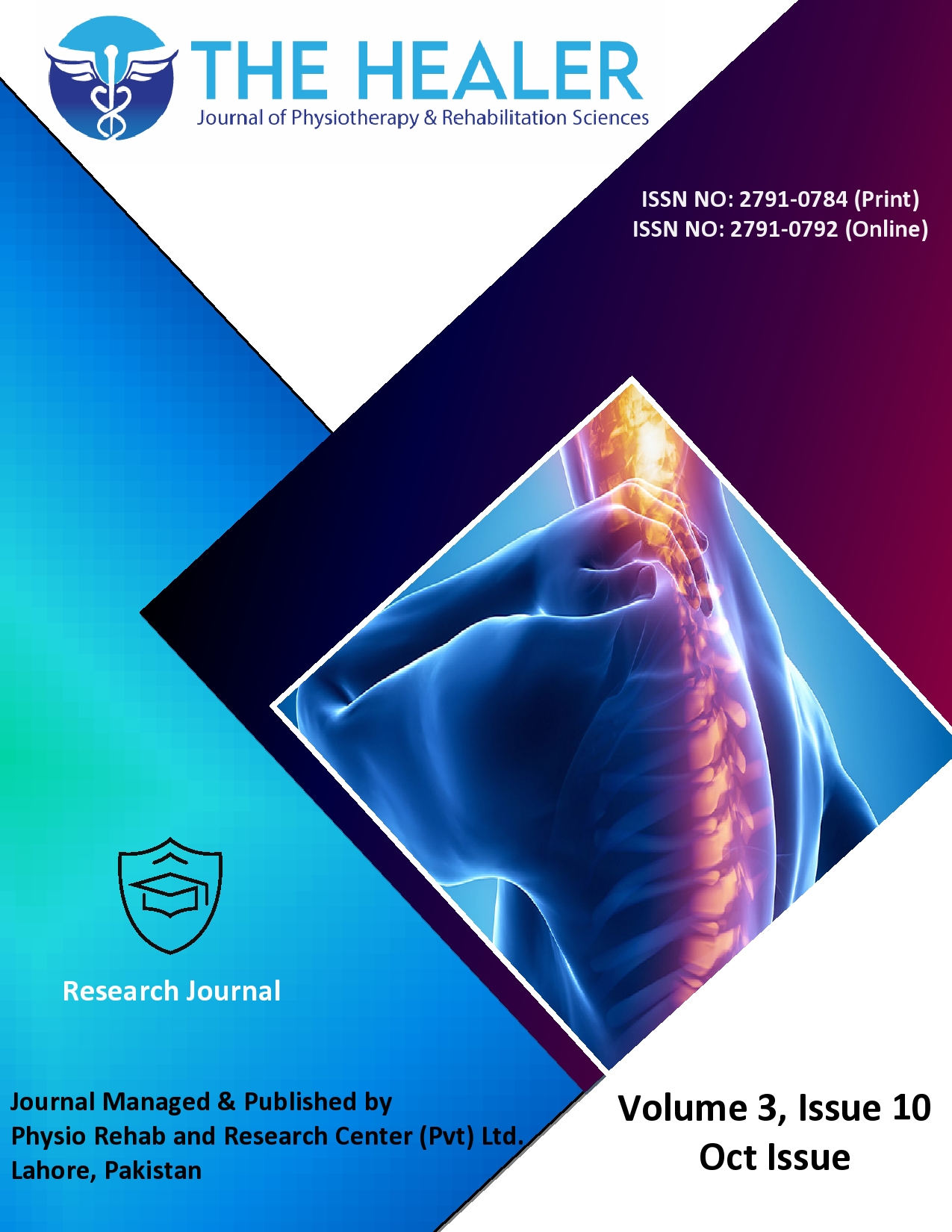Association of Body Mass Index and Static Balance Among Young Adults
Body Mass Index and Static Balance Among Young Adults
DOI:
https://doi.org/10.55735/hjprs.v3i10.202Keywords:
body mass index, postural stability, static balance, unipedal stance testAbstract
Background: Body characteristics are thought to affect postural stability apart from age and gender. Higher weight has increased the stress within joints, soft tissues and bones, and it results in impaired musculoskeletal function. Objective: The goal of this investigation is to gauge the relationship of BMI with static balance among young adults. Methods: This study was an analytical cross-sectional study. Data was collected from different universities in Lahore by using a non-probability convenience sampling technique. Permission was taken from the Departmental Research Committee of the University of South Asia and before taking the data informed consent was signed from the participants. Both males and females with an age range of 18-25 years were included. Participants with any recent history of injury to the spine and lower limb, and medicines that can change balance e.g., anti-depressants, anti-anxiety, antihistamines, or pain relievers and comorbidities like rheumatic disease, and neurological disease were excluded. The sample size was 385, calculated by using Rao software. Outcome variables were body mass index and static balance measured by the body mass index online calculator after taking height in feet and weight in kg and uni pedal stance test on both legs separately respectively. The uni-pedal stance test was performed by the participants, with their opened and closed eyes and their hands placed on their hips. Results: The mean age of 385 young adults was 21.28±2.2 years. There were 191 males and 194 females. There were 83 underweight, 234 normal, 52 overweight and 16 obese young adults. In the right uni pedal stance test with eyes open, only 47 young adults have a high risk of falling with impaired balance while with eyes closed 158 young adults have a high risk of falling with impaired balance. In the left uni-pedal stance test with eyes open, only 82 young adults have a high risk of falling with impaired balance while with eyes closed 201 young adults have a high risk of falling with impaired balance. Conclusion: There is no association between body mass index and static balance among young adults.
References
Cabeza-Ruiz R, García-Massó X, Centeno-Prada R, et al. Time and frequency analysis of the static balance in young adults with Down syndrome. 2011; 33(1): 23-8.
Kejonen P, Kauranen K, Vanharanta HJAopm, rehabilitation. The relationship between anthropometric factors and body-balancing movements in postural balance. 2003; 84(1): 17-22.
Son SMJOph, perspectives r. Influence of obesity on postural stability in young adults. 2016; 7(6): 378-81.
Ku PX, Osman NA, Yusof A, Abas WWJJob. Biomechanical evaluation of the relationship between postural control and body mass index. 2012; 45(9): 1638-42.
Do Nascimento J, Silva C, Dos Santos H, de Almeida Ferreira J, De Andrade PJCo. A preliminary study of static and dynamic balance in sedentary obese young adults: the relationship between BMI, posture and postural balance. 2017; 7(6): 377-83.
Alonso AC, Luna NMS, Mochizuki L, Barbieri F, Santos S, Greve JMDAJC. The influence of anthropometric factors on postural balance: the relationship between body composition and posturographic measurements in young adults. 2012; 67(12): 1433-41.
Ercan S, Demir H, Cetin CJJOO. The Association Between Strength, Balance And Physical Function With The Body Mass Index In Dyslipidemia. 2018; 4(1): 102.
Ward ZJ, Bleich SN, Cradock AL, et al. Projected US state-level prevalence of adult obesity and severe obesity. 2019; 381(25): 2440-50.
Albertsen IM, Ghédira M, Gracies J-M, Hutin ÉJJoe, kinesiology. Postural stability in young healthy subjects–Impact of reduced base of support, visual deprivation, dual tasking. 2017; 33: 27-33.
Greve JMDA, Cuğ M, Dülgeroğlu D, Brech GC, Alonso ACJBri. Relationship between anthropometric factors, gender, and balance under unstable conditions in young adults. 2013; 2013.
Cieślińska-Świder J, Furmanek MP, Błaszczyk JWJJoB. The influence of adipose tissue location on postural control. 2017; 60: 162-9.
Abaraogu UO, Ugwa WOJTJPMR. Selected anthropometrics, spinal posture, and trunk muscle endurance as correlated factors of static balance among adolescent and young adult males. 2016; 62: 9-16.
Jankowicz-Szymanska A, Mikolajczyk E, Wojtanowski WJRidd. The effect of physical training on static balance in young people with intellectual disability. 2012; 33(2): 675-81.
Physiopedia. Single Leg Stance Test. https://www.physio-pedia.com/Single_Leg_Stance_Test (accessed 2020 20).
Rezaeipour MJTjoms. Evaluation of postural stability in overweight and obese middle-aged men. 2018; 48(5): 1053-7.
Carral JMC, Ayán C, Sturzinger L, Gonzalez GJJogpt. Relationships between body mass index and static and dynamic balance in active and inactive older adults. 2019; 42(4): E85-E90.

Downloads
Published
How to Cite
License
Copyright (c) 2023 The Healer Journal of Physiotherapy and Rehabilitation Sciences

This work is licensed under a Creative Commons Attribution 4.0 International License.
CC BY


